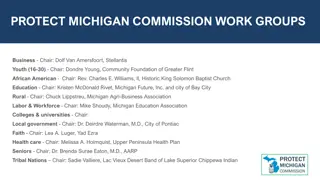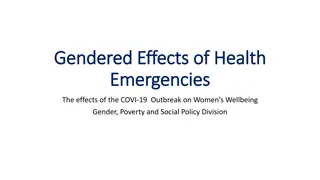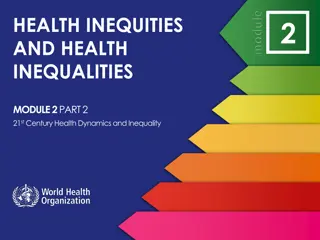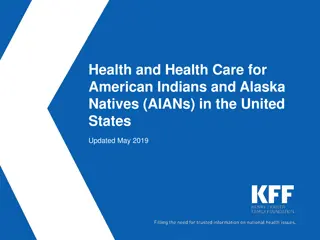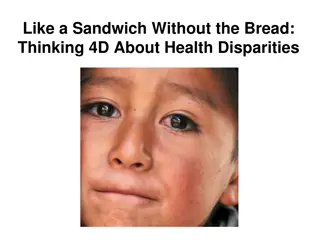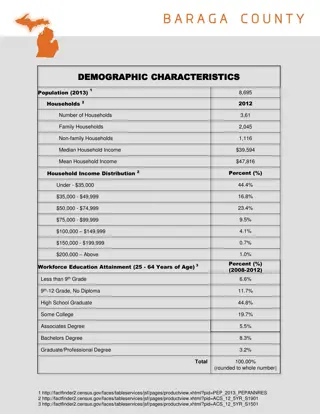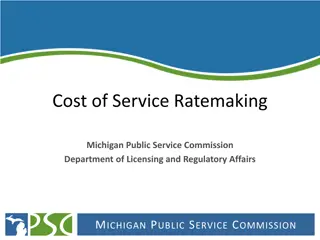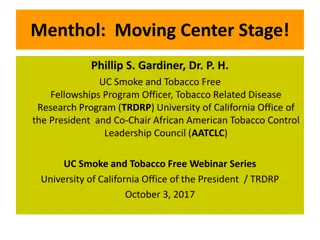Analysis of Work, Health Disparities, and COVID-19 Impact in Michigan
This report examines the occupational disparities and COVID-19 impact on different racial groups in Michigan. It details the most common occupations for Whites, Blacks, Asians, and Hispanics, along with COVID-19 death rates by industry and occupation. The data reveals significant variations in mortality rates among different employment sectors and racial categories.
Download Presentation

Please find below an Image/Link to download the presentation.
The content on the website is provided AS IS for your information and personal use only. It may not be sold, licensed, or shared on other websites without obtaining consent from the author. Download presentation by click this link. If you encounter any issues during the download, it is possible that the publisher has removed the file from their server.
E N D
Presentation Transcript
Work, Health Disparities and COVID-19 https://oem.msu.edu/images/newsletter/ProjectSensor/2020/Fall2020_Newsletter_V31N4.pdf Kenneth D. Rosenman, M.D. Professor of Medicine Michigan State University www.oem.msu.edu Rosenman@msu.edu 517-353-1846
Ten Most Common Occupations for Whites, Blacks, Asians and Hispanics in MI: Grouped by Categories- Manager/Professional, Clerical/Sales/Service, and Trades/Operators/Manual Laborers Asian (# employed: 129,414) Manager/professional Mechanical engineers (9%) Software developers (7.5%) Postsecondary teachers (4.2%) Computer/information systems managers (3.9%) Physical therapists (3.6%) Managers (3.4%) Nurses (3.2%) Accountants (2.9%) Physicians (2.7%) Clerical/sales/services Maids and housekeeping cleaners (2.7) Hispanic (# employed: 161,489) Manager/professional Accountant (2%) Clerical/sales/service Janitors (3.9%) Retail salespersons (2.7%) Waiters/waitresses (2.7%) Cooks (2.3%) Food preparation workers (2.1%) Trades/operators/manual labor Agricultural workers (9.8%) Assemblers and fabricators (4%) Grounds maintenance workers (2.9%) Packers and packagers, hand (2%) White/non -Hispanic (# employed: white-3,558,662; non-Hispanic-4,041,165) Manager/professional Manager, all other (2.1%) Nurses (2.1%) Elementary/middle school teachers (2.1%) Clerical/sales/service Cashiers (2.4%) Retail salespersons (2.4%) Secretaries (2.3%) Supervisors of retail sales workers (1.9%) Waiters/waitresses (1.6%) Trades/operators/manual laborers Drivers/sales workers and truck drivers (2.3%) Black (# employed: 435,105) Clerical/sales/service Nursing/home health aides (4.7%) Personal and home care aides (2.8%) Cashiers (2.8%) Customer service representatives (2.4%) Retail salespersons (2.3%) Cooks (2.2%) Trades/operators/manual labor Janitors (3.1%) Laborers (2.5%) Bus drivers (2.1%)
Number and Rate/100,000 Employed of COVID-19 Deaths by Industry, Overall and among Non-Black and Blacks, Michigan 3/10/20- 6/23/20, Age 18-70 Years # of COVID Deaths ment Rate COVID Deaths All 1,510 2.57 Agriculture 6 0.94 Arts & Entertainment 35 1.99 Construction 98 3.12 Educational 75 1.50 Finance & Insurance 35 1.54 Food Service 82 1.90 Health Care 231 3.24 Information 19 2.24 Manufacturing 344 3.31 Military 8 11.79 Mining 1 1.18 Other Services 111 9.82 Professional/Scientific/Tech 128 2.22 Public Administration 79 3.98 Real Estate 13 2.27 Retail Trade 126 1.95 Transportation 89 4.29 Utilities 16 3.39 Wholesale Trade 14 1.10 Black to Non- Black Rate Ratio Total Employ- Non-Black Non-Black Rate Black COVID Deaths Black Rate 11.37 0.00 9.74 31.50 10.52 5.53 5.14 12.72 11.54 16.22 129.15 0.00 32.84 9.67 17.08 12.51 7.65 11.16 13.54 4.40 9.3 625 1.22 0.97 0.97 1.45 0.47 0.96 1.21 1.42 0.81 1.52 1.60 1.20 4.75 1.04 2.80 1.16 1.28 2.30 1.04 0.70 885 -- 6 0 10.0 21.7 22.4 5.8 4.2 9.0 14.2 10.7 80.7 15 43 21 19 43 85 20 55 54 16 39 146 13 205 6 139 1 1 7 0 -- 6.9 9.3 6.1 10.8 6.0 4.9 13.0 6.3 44 52 46 67 76 58 6 7 74 37 52 52 12 4 8 6
Number and Rate/100,000 Employed of COVID-19 Deaths by Occupation, Overall and among Non-Black and Blacks, Michigan 3/10/20-6/23/20, Age 18-70 Years # of COVID Deaths ment Rate Deaths 1,735 2.90 Architecture & Engineering 28 1.96 Arts & Entertainment 28 2.61 Business & Financial 40 2.44 Community & Social 44 1.78 Computers & Math 17 1.20 Construction 75 2.90 Education 39 1.26 Farm/Fish/Forest 7 1.86 Food Prep & Serving 61 1.56 Healthcare Practitioners 64 1.83 Healthcare Support 58 2.66 Installation/Repair 55 3.37 Legal 9 1.81 Life/Physical/Social Science 5 1.11 Maintenance 95 3.84 Management 87 1.74 Office/Admin Support 144 2.19 Personal Care 64 3.65 Production 190 3.67 Protective Service 50 5.42 Sales 101 1.75 Transportation 475 10.03 Total Employ- Non-Black COVID Black COVID Deaths Black to Non- Black Rate Ratio Non-Black Rate Black Rate All 744 14 1.46 1.04 0.92 1.30 0.55 0.61 1.58 0.50 1.68 0.86 1.13 0.92 2.24 1.54 0.48 1.56 1.02 1.12 1.01 1.78 1.91 1.02 5.30 991 14 19 21 33 12.7 17.43 21.25 12.06 6.88 8.16 20.72 8.19 5.46 5.01 9.06 7.86 18.21 4.86 8.74 13.33 10.34 8.64 18.20 12.13 18.93 7.94 31.75 8.7 16.8 23.1 9.3 12.5 13.4 13.1 16.4 3.3 5.8 8.0 8.5 8.1 3.2 18.2 8.5 10.1 7.7 18.0 6.8 9.9 7.8 6.0 9 19 11 8 9 38 14 37 25 6 1 28 36 15 34 33 28 43 21 7 2 2 3 31 47 63 15 75 14 53 64 40 81 49 115 36 48 269 206
Distribution of Duration of Work for Black and White Workers 50 40 Percent 30 20 10 0 0-9 10-19 Duration (years) 20-29 30+ African-American Caucasian Rosenman et al. (Am J Epid 1996; 144:890-900)
Distribution of Cumulative Silica Exposure for Black and White Workers 50 40 Percent 30 20 10 0 <240 Cumulative Silica Exposure (mg-day/m3) 240-720 >720-2,160 >2,160 African-American Caucasian Rosenman et al. (Am J Epid 1996; 144:890-900)
Summary 30% of COVID Deaths are Within Usual Working Age Differential Rates by Industry/Occupation Differential Rates by Industry/Occupation is Greater for Blacks High ratio of of black to white mortality rates by Industry/Occupation More Work Needed to Determine Why







